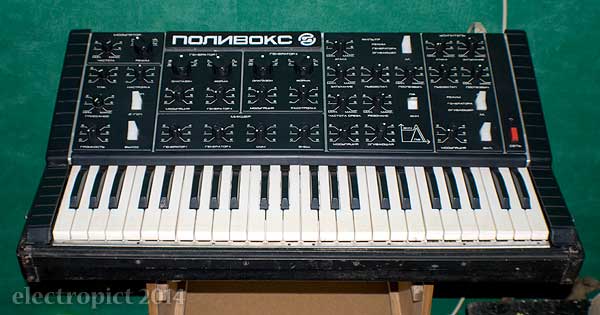
Hey, got a Polivoks.
First, some points of nomenclature. I’ve had no occasion hitherto to consider it, but I now realise the correct English plural of Polivoks is Polivoksen. With that established, on the Polivoks:
- Generator (Генератор) = tone generator = (audio frequency) oscillator = VCO.
- Modulator (Модулятор) is mainly an LFO. (The control can select noise as well as periodic functions, so LFO would be incorrect . . . a less cumbersome term than Korg’s ‘modulation generator’.)
- Glissando (Глиссандо) = portamento (a.k.a. ‘glide’).
- Pedestal (Пьедестал) = sustain level.
I’ll use the Polivoks terms here, mostly.
This Polivoks was made in 1987, and came with lid, pedal and cables (5-pin and 3-pin DIN; don’t know what the 3-pin one was for . . . ). No power cable but has an IEC C-14 power socket mod. [1]
External Condition
Case: not great; sticky tape residues, heavily scraped and rather indented. So much for all the “built like a tank” guff. Built like a fake tank for to confuse the enemy, maybe. Sheet aluminium bends (like plastic, unlike steel) but doesn’t rebound. It seems to have had carry handles at either end; not sure if they were original, but gone now. The rubber feet on the underside are different sizes — presumably two were replaced at some point.
Condition under the cover is dusty rather than dirty. Much of the dust is sort of ingrained in the cracks. Some of it resembles yellow lichen . . . probably not, as it wasn’t left outside in a fresh Northern climate for a few months . . . or was it?
The control panel is in fairly good shape, though the nameplate is a recent and rather dodgy retrofit . . . different plastic, cut to a different radius; has a print from a low-res bitmap image of the name stuck on top . . . I can do better than this.

The front plastic trim under the keyboard is missing. One half of the rear trim is loose: it shows signs of having been glued on previously.
The pots and rotary switches are all D-shaft. The original smaller knobs are two-part, inner and outer. This permits the indicator position to be adjusted, necessary because the chamfers are all over the place.
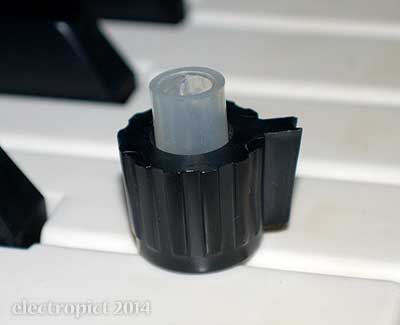
Three control knobs have been replaced with non-Polivoks knobs. (Identical to the original knobs on the RMIF Elsita.) They don’t seem to fit exactly, and aren’t intended for D-shafts; they turn past their control limits way too easily. That could do with fixing. (But at least I have some Elsita spares now. )
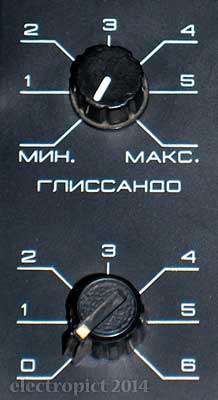
The larger knobs, on the switches, have the chamfer built-in, and their switch positions are consistent. They also have one or two steel shims holding them on — which can go flying, or fall inside the panel, on removal — or insertion. One of these was glued in. Not good, as it required significant force to remove and the pots and switches are PCB mounted — not panel mounted.
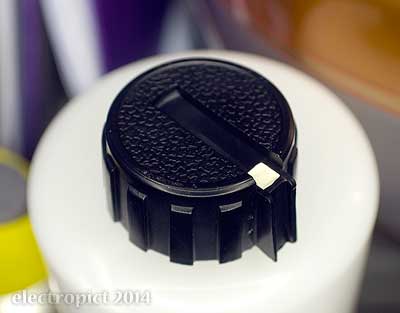
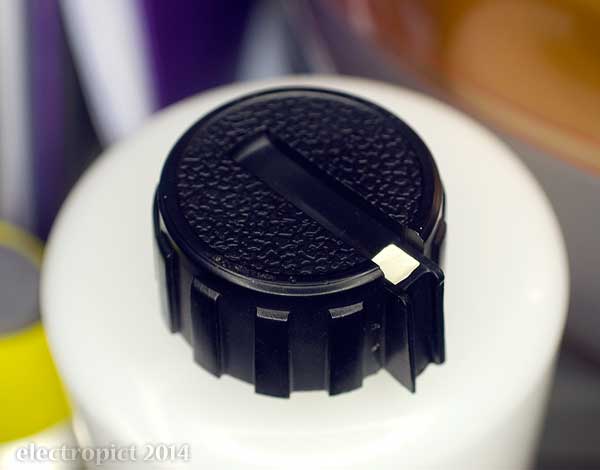
As well as the power input mod the i/o ports other than pedal have been replaced with ¼″ jacks. This mod seems to have involved removing two of the plastic rear panels to get at the socket and screwing them back in. They were originally riveted on (molten-plastic type riveting).
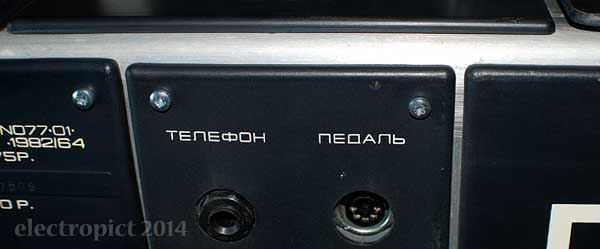
There’s a loose screw caught under the keyboard. (Removed.)
Keys condition — not great, but probably not bad as Polivoksen go. Perhaps poorly made rather than suffering o’ermuch since. Playable, and not bromine yellow. Makes a bit of a racket, which might be fixable.
The rotary selector switches are the stiffest turns I’ve encountered. The toggle switches are the lightest, flicking up and down with the least effort. They appear flimsy but are made of a slightly flexible plastic, and are undamaged.
Unusually for synthesisers, this has built-in carry handles in the end panels. Excellent decision.
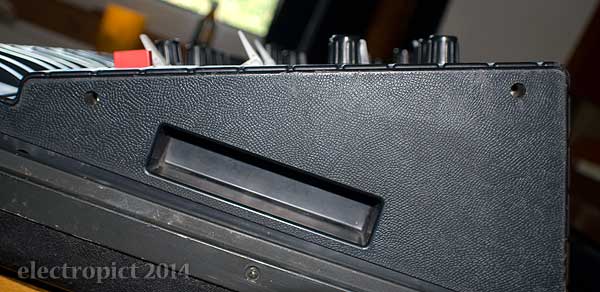
I have read that the build quality of Polivoksen was inconsistent. This one seems a bit rough. Additionally, the case — including the bottom of the synth — has been bashed about, and no longer really fits, if it ever did. There may be an argument for rebuilding the body . . . wood ends maybe? I haven’t seen that being done to Polivoksen yet. I wonder . . . Sufficient ebony for the end panels would probably cost over a hundred (sterling); so maybe another hardwood, black-dyed. Or . . . I wonder if anyone has ever made synth end panels out of stone . . . Black granite? [2]
Interestingly the existing Polivoks base and lid are made out of basically single sheets of aluminium, folded over a wide radius and joined with preformed corner pieces. Not sure it beats a wood body and a flight case.
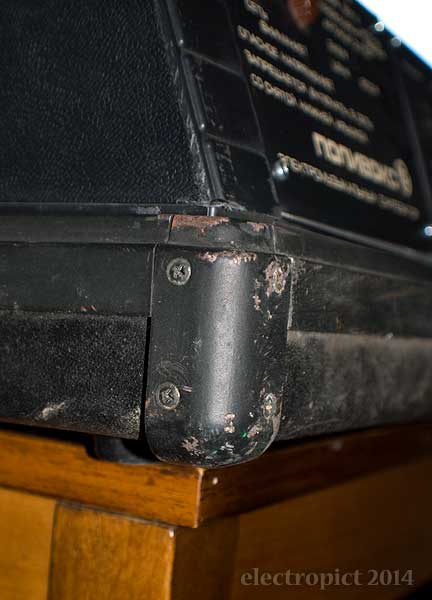
Issues:
- IN1: Replacement nameplate could do with replacement. Non-critical.
- IN2: Front trim missing; could do with replacing. Non-critical.
- IN3: Elsita-type knobs could do with replacing. Preferable.
- IN4: Key damping. Consider when disassembling keyboard later.
- IN5: General body condition. Consider significant case mod. Or maybe panel beating/suction. Non-critical.
Interior, Electrical & Audio Condition
There are things rattling around inside. Multiple things.
The top F♯ isn’t making contact. These keys apparently use reed switches; need to open it up and see what type.
After some experimentation it seems the way to open a Polivoks is to:
- remove the rubber feet on the underside; the bolts serve a dual purpose of holding the underside onto the end panels;
- remove the centre two bolts (out of four) in the front of the case, which screw into fixing points in the frame under the keyboard.
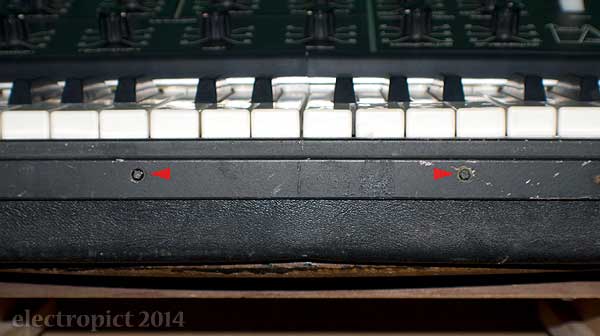

Then it just lifts out. (Lift at the back first; reinsert front first.)
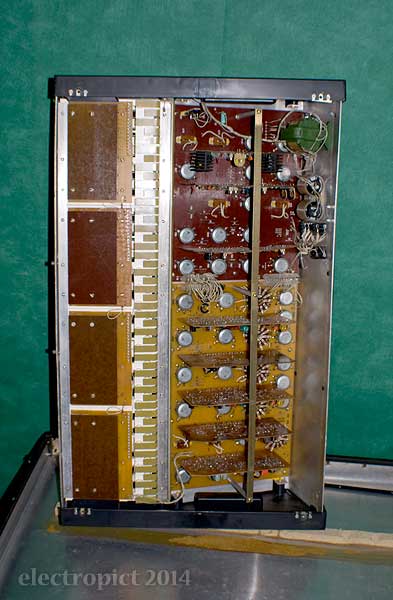
The rattles were broken bits of end-panel, and a hex nut. The Polivoks circuitry is constructed as a pair of backpane boards which hold the switches and pots, with daughterboards which do the bulk of the signal manipulation. These are held in place by a single metal strap which is bolted through to the front panel.
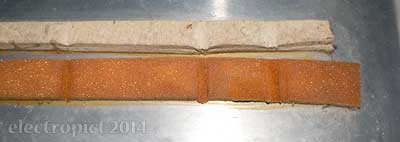 The source of the lichenlike substance is rotted old foam padding which would once have held the daughterboards steady and/or protected them from the bottom of the (subsequently indented) case on impact. It’s not abnormal for this kind of foam to rot in under a decade; 27 years is pushing it. It was caught on the PCBs and in various cracks around the synth.
The source of the lichenlike substance is rotted old foam padding which would once have held the daughterboards steady and/or protected them from the bottom of the (subsequently indented) case on impact. It’s not abnormal for this kind of foam to rot in under a decade; 27 years is pushing it. It was caught on the PCBs and in various cracks around the synth.
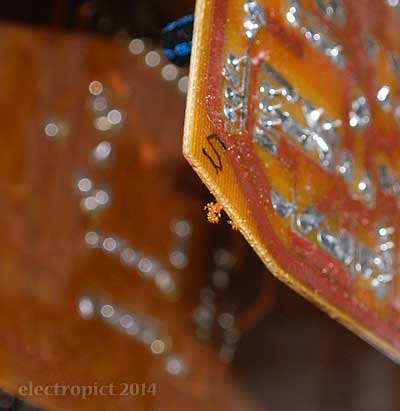
 The foam was in such poor state the whole block just crumbled away up the vacuum cleaner hose (on low-power). There’s also a strip of felt which seems to be providing support against longitudinal rather than lateral movement; it’s basically good as new. This arrangement still permits the PCBs to warp, and indeed some have, one significantly:
The foam was in such poor state the whole block just crumbled away up the vacuum cleaner hose (on low-power). There’s also a strip of felt which seems to be providing support against longitudinal rather than lateral movement; it’s basically good as new. This arrangement still permits the PCBs to warp, and indeed some have, one significantly:
 (Now that’s what I call circuit bent.
(Now that’s what I call circuit bent. ) As I’m not planning to transport it anywhere I’ll leave the foam unreplaced for the time being. While I consider body mods.
On a cursory inspection there is no obvious circuit damage; the loose screw seems to be a retaining screw for one of the octave boards; this (and others) has been replaced.
It looks like getting into the keyboard will take a bit more working space than I currently have available. (Substantial space is planned later in the year.)
The Formanta factory doesn’t seem to have used colour-coded wiring. But with this backpane/daughterboards design, there is relatively little of it. Which has advantages.
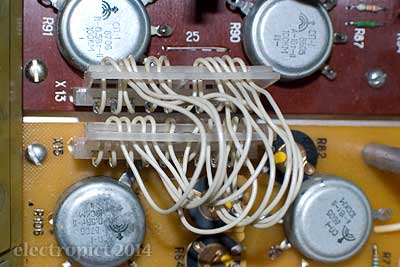
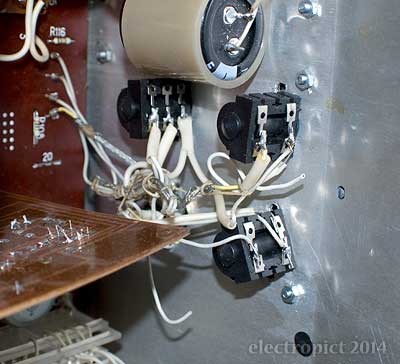 The original main DIN output would have been balanced; it has been replaced with a mono jack. An XLR would have been nice; but maybe this could be upgraded.)
The original main DIN output would have been balanced; it has been replaced with a mono jack. An XLR would have been nice; but maybe this could be upgraded.)
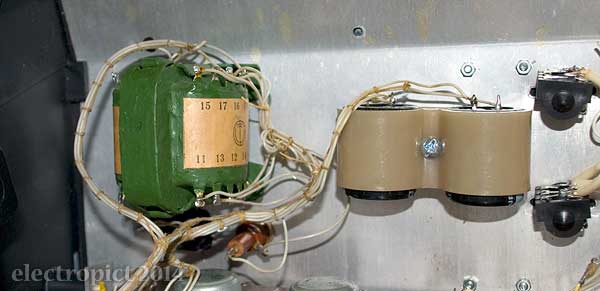
The mains transformer and capacitors are, unusually, bolted to the rear panel. (Nice coated transformer there, don’t see them very often.) This is the obvious alternative to putting them on the base — which here is the outer case — which as we know, gets bashed about. But this is still sheet aluminium, and doesn’t shout ‘strong enough to support a transformer’. As against which, it’s survived 27 years of bashing and gigging through the collapse of the USSR, some years in one or more successor states, and journeys as far as Scotland.
Other than the key, it’s functioning, though in need of tuning. In addition to the main and Generator 2 tuning controls the Polivoks also allows easy access to the relevant trim pots — just pull the nameplate off. (Which is how the nameplates come to need replacing . . . ) It helps to know which is which . . . I haven’t found any full manual translation, but tuning instructions are at: ruskeys.net/eng/pasp/polivoks/pasp.php

This method of access is simply superb, as it allows full retuning not only easily, but also under playing conditions — most other synths, you need to open the case up (if possible) and expose the circuits to lower air temperatures than they will be played in, which could have some impact . . . in an empty, unheated dance hall in Winter, before the audience and their carry-outs arrive to make heat with you. Shame the nameplate wasn’t hinged to avoid it going astray, but still, superb. (Apparently some of the transistors in the Polivoks are light-sensitive, which might make it impossible to tune when open anyway. I don’t know.)
Some controls don’t respond much over large arcs of travel, then are very sensitive in small areas. Possibly there are other calibration issues than just tuning . . . ? More likely they’re just substandard pots. Yet surprisingly, no crackling from them — I’ve never had a synth before that didn’t crackle when I got it. Perhaps it’s had a recent clean-out. There is some hissy noise at high gain, which apparently is normal for Polivoksen?
As expected, it can generate quite a bit of overdrive and screaming with the resonance high. In general though, the sound is surprisingly mushy. It’s early days, but while some sounds I’ve found work quite well, mostly it’s not great. This may also be a calibration / elderly components issue. Why do I keep thinking accordion?
Oddly, on this Polivoks, neither the headphone nor the main output signals reach complete silence with their pots turned down. Not a huge problem, but suspect. (Could the aforementioned hissing be the white noise circuit not quite reaching zero?)
Weirdly, even when warmed up, the generators (both) frequently miss their pitch in the second (F–E) octave of the keyboard — though not each key of the octave. They can start over half a semitone out, then jump up to the correct pitch after a second or so, though with some subsequent variation. (It’s slightly like playing an aftertouch keyboard — but only slightly like.) This implies bad connections or other voltage level problem . . . ? Maybe fixable. Come to think of it, this is the octave that has its PCB screws replaced . . . Possibly we’re hearing the remnant of an earlier fix . . .
Issues:
- IN6: Dead key. Examine reed switch type when disassembling keyboard, replace.
- IN7: Functioning of second octave. Examine and test components and connections in that area.
- IN8: Control pots and other components are in a questionable state. Detailed tests when workspace available.
Polivoks Function Observations
(Based on how it appears to work, where this seems to be deliberate — assuming this one works as intended. Comments and corrections welcome.)
As with many other old multi-oscillator synths there is no oscillator sync method; they are independently manually tuned. Like a piano, but easier. Consequently there can be significant interference troughs; you can’t get them quite in tune all across the keyboard. Deliberate detuning to shorten the troughs seems to be the normal solution, but that seems to work less well with the Polivoks — if you’re after a smooth sound. (But who uses Polivoksen for smooth sounds?) It’s easier if you’re feeding oscillators into separate filters . . .
Key priority is high. (Update: Except in 2-voice mode, when the uppermost and lowermost key pressed both have priority over anything in between.)
Only single triggering (slur mode) is available. Even in two-voice mode. [3]
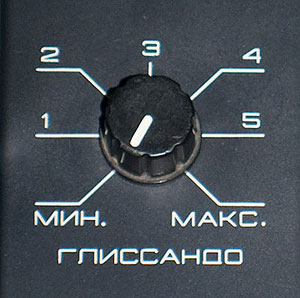
ГЛИССАНДО (glissando) seems to only affect Generator 1 by design — but it does slightly affect Generator 2 — on this Polivoks at least. (I’ve wanted to try out combined glissando/stepping sounds for some time. First results here are delightful — better than the Yamaha CS-15 with glide. Add some chorusing delay and we have ourselves a little choir in a box.)
Both the filter and amplifier have retrigger modes (РЕЖИМ ГЕНЕРАТОРА ОГИБАЮШЕЙ switches [4]), in which the envelopes repeat their Attack and Decay (Атака & Затухание) phases until key-up — giving us a pair of periodic effects the length of which is the sum of each attack+delay. But amplitudes now rise and fall continuously, seemingly not between zero and peak, but between sustain level and peak, and the effect is only audible with Pedestal turned low. [5] The repeats are followed by a release at key-up, but the release amplitude starts from wherever we are in the cycle, which can give unpredictable results.
The pedal is a modifier for the filter cutoff point. With this Polivoks at least, it adds a little bit extra to the total, roughly a tenth of a pot turn. And just plugging it in adds a small amount — something here isn’t reaching zero either.
There’s been some confusion on the web over some functions (in English language circles at least, or translated-into-English, which may not be the same thing). My conclusions are:
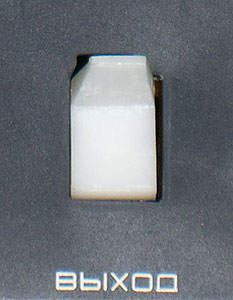 The ВЫХОД (output) switch. Lifting this switches the main output — but not the headphone output — off. Some commentators seem confused by this, but really it’s just a mute control, which allows the player to do their tweaking with headphones (or monitor), without affecting the live performance. A sound tech can do that for you, but for smaller setups it’s convenient to not have to reach over to the amp. [6]
The ВЫХОД (output) switch. Lifting this switches the main output — but not the headphone output — off. Some commentators seem confused by this, but really it’s just a mute control, which allows the player to do their tweaking with headphones (or monitor), without affecting the live performance. A sound tech can do that for you, but for smaller setups it’s convenient to not have to reach over to the amp. [6]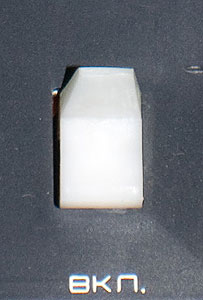 The ВКЛ. (on) switch. This is described as key follow or key memory on some sites. But it’s basically a sustain switch. With it on only generator pitch responds to keypresses. However, it does allow the retrigger functions to operate. [7] (Update, 2023-02-12: It seems вкл. is an abbreviation of включить (vklyutsitʼ), meaning switch on, and related words. So this is a on on/off switch for the envelope.)
The ВКЛ. (on) switch. This is described as key follow or key memory on some sites. But it’s basically a sustain switch. With it on only generator pitch responds to keypresses. However, it does allow the retrigger functions to operate. [7] (Update, 2023-02-12: It seems вкл. is an abbreviation of включить (vklyutsitʼ), meaning switch on, and related words. So this is a on on/off switch for the envelope.)
Future
Repair dead key. Detailed check of electrical function, replace any other failing components, recalibrate.
Some possible (or possibly desirable) mods:
- generator CV / envelope trigger i/o;
- full filter CV in;
- modulator clock external sync i/o;
- generator 1/2 sync;
- balanced main output;
- PWM;
- Glissando on/off per generator or glissando per generator;
- single/multiple trigger switching (for each envelope);
- improve or replace case.
Need to work out if some of these are doable. Basic CV/trigger certainly is. I see there is also what looks like a very basic MIDI connection kit available . . . not convinced, personally.
This post has been updated in Polivoks Update.
Comment or Question about this page? write
Notes
- A plus on the basic Polivoks is that it has a power socket, not a flying lead. Not a C-14; an older, 2-pin type I can’t distinguish in photos. ↖
- I think, whether Polivoks or not, one day a synth should be built in a granite case (though an approach to temperature stabilisation would need to be worked out). Would that make it monolithic? And at least one Polivoks should probably be put in a dark wood and brass case. With brass or brass/wood controls . . . And how about an all-stainless-steel Polivoks? ↖
- That is, only one trigger signal is in operation at a time. A new keypress will not override a previous trigger signal — until the trigger-off is received, the envelopes are not retriggered, so (subject to key priority) only generator pitch will change. Most monosynths I know have only multiple triggering (a new higher priority trigger-on will override the old trigger). Apart from the Yamaha CS-10 and CS-30, which can switch modes, I don’t remember single-trigger on any other synth I’ve used. Here, even in two-voice mode, a second keypress will not retrigger the envelopes. To get a complete note with attack/decay you have to close the original gate — i.e. lift the first key. ↖
- Rezhim Generatora Ogibayushey? — “envelope generator mode”? ↖
- Conceivably if the control pots operated smoothly over their full turn, keeping Pedestal higher would not cause the effect to become inaudible. Incidentally, Decay, Затухание (Zatukhanie) I think is actually “damping” in Russian? ↖
- By 1982 many Western-bloc synths had memory functions which might make it unnecessary, but 32 years later, I still don’t have one. ↖
- Some synths have hold or gate switches. Loosely speaking, they should produce permanent peak level as distinct from sustain. But definitions aren’t standardised, and certainly weren’t in the 1970s and 80s, so it varies. ↖
Article text ©2014–2023 Electropict  .
.
Click images for individual licences.
